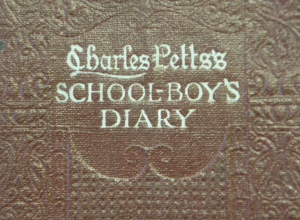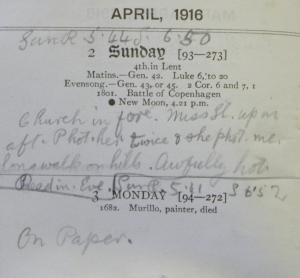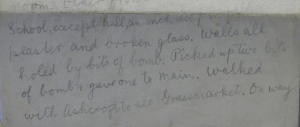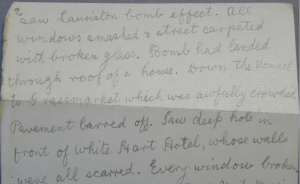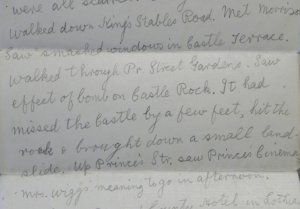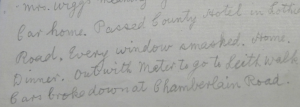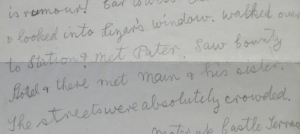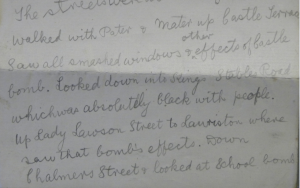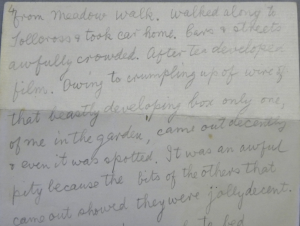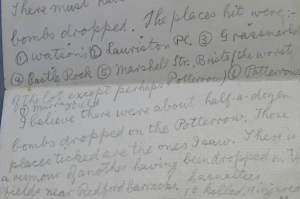A STORY FROM THE DIARY OF 15-YEAR OLD ARCHIBALD H CAMPBELL (1902-1918) WHO WOULD LATER BECOME REGIUS PROFESSOR OF PUBLIC LAW AND THE LAW OF NATURE AND THE NATIONS, EDINBURGH UNIVERSITY, 1945-1972
Over the next couple of days, and almost 100-years to the day since the first ever air assault on Leith and Edinburgh by Zeppelins of the Imperial German Naval Airship Service, our blog describes the event – on 2-3 April 1916 – as told by the diary of the young teenager Archibald Campbell, and also through interpretation of historical papers of the Royal Infirmary of Edinburgh curated by the Lothian Health Services Archive (LHSA).
Firstly… Archibald Campbell’s story…:

Airship – similar to Zeppelin L14 of the Imperial German Naval Airship Service which brought most of the damage to Edinburgh from the air in April 1916. In addition to Edinburgh, many other places on Great Britain suffered from Zeppelin raids including Kings Lynn, Gt. Yarmouth, Hull, Tyneside, Gravesend, the Midlands, London and the Home Counties. From January 1915 to end-May 1916 at least 550 British civilians had been killed (Creative Commons image).
Archibald Hunter Campbell was born 21 May 1902 in Edinburgh. He was educated at George Watson’s College in the city, at Edinburgh University, and then at University College, Oxford.
While still at school, aged 13 years, Campbell witnessed the aftermath of this first ever air attack on the city, and on Scotland as a whole, when the airships – the Zeppelins – dropped ordnance on 2-3 April 1916.
The naval base at Rosyth in Fife and the Forth Bridge had been the focus of an attack composed of four Zeppelins but in the event only two craft reached the Scottish coast – L14 commanded by Kapitänleutnant der Reserve Alois Böcker, and L22 commanded by Kapitänleutnant Martin Dietrich. At 9.30pm on Sunday 2 April 1916 the military gave the order for the city to take air raid action, and road traffic ground to a halt, street lighting was lowered, and civilians were advised to take refuge.
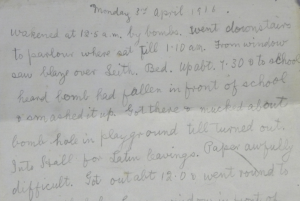
Descriptive notes from the diary kept by Archibald H. Campbell and telling the story of the Zeppelin attack (Coll-221).
Leith Docks were attacked round about 11:30pm, and then the German airship crew plotted a course along the Water of Leith towards the city of Edinburgh. Just after midnight the young Campbell was awakened by the sound of bombs. He went down to the parlour where he waited until 1.10am on the morning of Monday 3 April and from the window he ‘saw blaze over Leith’. He then went to bed before rising again at 7.30am to get ready for school – George Watson’s. However he heard that a ‘bomb had fallen in front of school & smashed it up’. When he got to school he ‘mucked about’ in the bomb hole in the playground until he was ‘turned out’ of it.
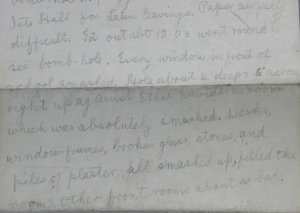
Descriptive notes from the diary kept by Archibald H. Campbell and telling the story of the Zeppelin attack (Coll-221).
At noon when he got out of school he ‘went round to see bomb hole’ again. Every window in front of the school was ‘smashed’. The crater was ‘about 4′ 6” across right up against Ethel Davidson’s room which was absolutely smashed’ (the crater was just over a meter wide). He went on…:
Desks, window-frames, broken glass, stones, and piles of plaster, all smashed up, filled the room. Other front rooms about as bad.
All windows smashed & street carpeted with broken glass. Bomb had landed through roof of a house.
It had missed the Castle by a few feet, hit the rock & brought down a small land slide.
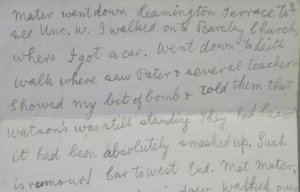
Descriptive notes from the diary kept by Archibald H. Campbell and telling the story of the Zeppelin attack (Coll-221).
Later on, when his mother had gone down to Leamington Terrace to see an uncle, Campbell ‘got a car’ (a tram) down to Leith Walk where he met his father and several teachers, and…:
Showed my bit of bomb & told them that Watson’s was still standing.
Saw all smashed windows & other effects of Castle bomb. Looked down into King’s Stables Road which was absolutely black with people.
Owing to crumpling up of wire and that beastly developing box only one […] came out decently & even it was spotted.
 Nearly all of the damage had been caused by devices dropped from Zeppelin L14. Zeppelin L22 ventured only briefly into the city and just caused minor damage after jettisoning most of its bombs in fields near Berwick-upon-Tweed. Later in the year, Alois Böcker was arrested by local policemen in Essex, England, in September 1916, when his Zeppelin (L33 on this occasion) was brought down by night fighters. Zeppelin L14 itself was destroyed by its crew on 23 June 1919 following the example of the naval scuttling in Scapa Flow.
Nearly all of the damage had been caused by devices dropped from Zeppelin L14. Zeppelin L22 ventured only briefly into the city and just caused minor damage after jettisoning most of its bombs in fields near Berwick-upon-Tweed. Later in the year, Alois Böcker was arrested by local policemen in Essex, England, in September 1916, when his Zeppelin (L33 on this occasion) was brought down by night fighters. Zeppelin L14 itself was destroyed by its crew on 23 June 1919 following the example of the naval scuttling in Scapa Flow.
At Bletchley Park he was a Foreign Office Civilian (Temporary Senior Assistant Officer) and worked at the Mansion, Hut 10, Block A and Block F(A), Air Section, including advanced research in the Italian sub-section. There he decrypted non-Enigma signals from German, Italian and Japanese Air Forces and produced intelligence reports. He also worked at Hut 5 and Block F, Military Section, probably Japanese, involved in decrypting and reporting on non-Enigma enemy army ciphers. This was also known as No 4 Intelligence School.
After the war he returned to Edinburgh and to the University’s Regius Chair of Public Law and the Law of Nature and the Nations which he held from 1945 to 1972. He was Dean of the Faculty of Law, 1958-64.
Professor Archibald Hunter Campbell died in Edinburgh 8 June 1989.

The diary with the separate page describing the damage across Edinburgh was ‘rediscovered’ in the A. H. Campbell material by one of our volunteers, Valentina Flex, Edinburgh University graduate, who had been creating a provisional listing of content.
A second blog post about the attack on Edinburgh 100-years ago – and from the curatorial staff of the LHSA – will go live in the next couple of days.
Dr. Graeme D. Eddie, Assistant Librarian Archives & Manuscripts, Centre for Research Collections
Notes…: In addition to the description of the events written by Archibald H. Campbell himself, freely accessible web-pages describing the events of 2-3 April 1916 (especially Scotland’s War ‘Midlothian’s War – Zeppelin raid over Edinburgh’) and a ‘Wikipedia’ list of Zeppelins, and also the website of the Bletchley Park Roll of Honour, were enlisted for the creation of this blog-post.
The image of the Zeppelin (here the P-class LZ45 ‘L13’) was obtained from Creative Commons.
The second story about the Zeppelin attack can be read here: II: Incendiary bombs and the Infirmary

